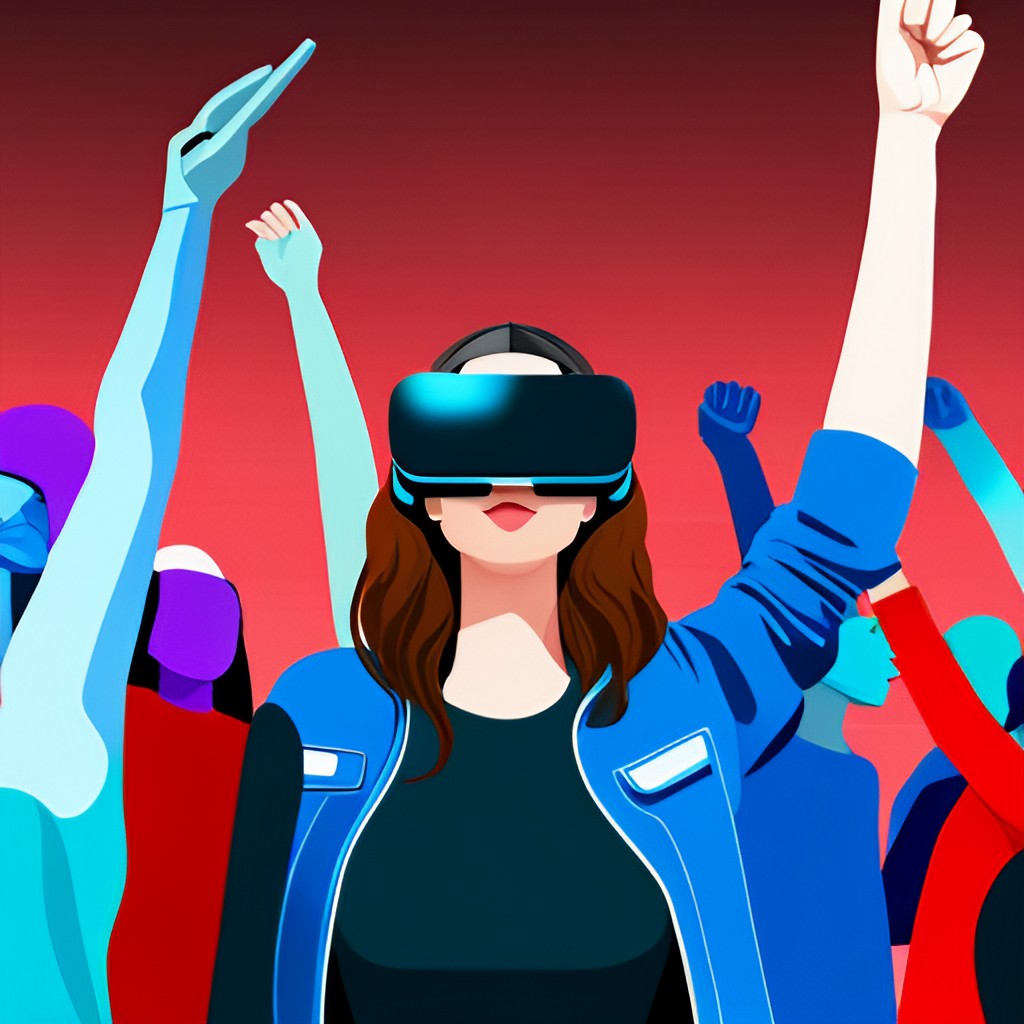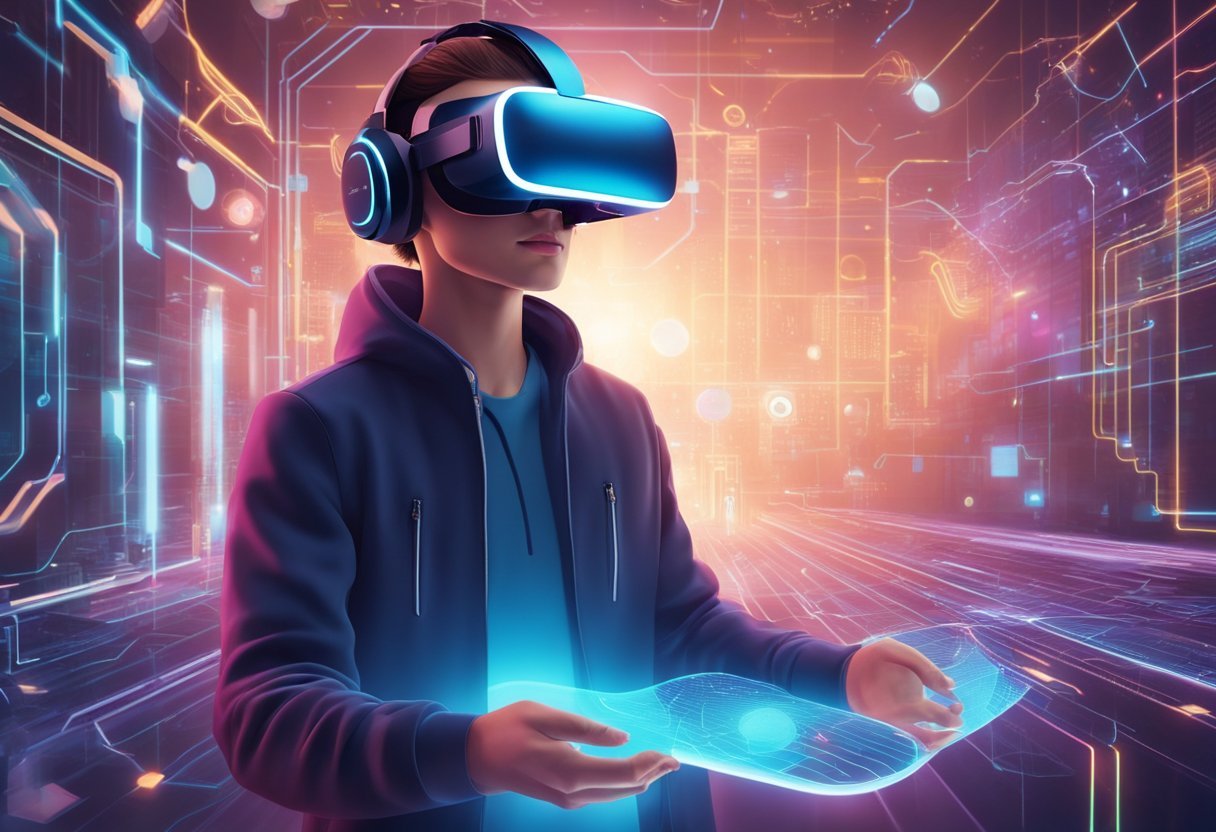The concept of a metaverse has been around for decades, but it has recently gained more attention as technology has advanced. The metaverse is essentially a shared virtual space where users can interact with each other and digital objects in a three-dimensional environment. It is often compared to a massive multiplayer online game (MMO), but with more immersive and persistent elements. So how does the metaverse work?
The metaverse is made possible by a combination of virtual reality (VR), augmented reality (AR), and other advanced technologies. Users can enter the metaverse through various devices, such as VR headsets, and interact with others and the environment through avatars. The metaverse is not just a game or a social network, but a new kind of internet where users can engage with each other and digital content in a more immersive and interactive way.
To create the metaverse, developers use a variety of technologies such as 3D modeling, physics engines, and artificial intelligence. The goal is to create a seamless and persistent virtual world that can be accessed by anyone with an internet connection. The metaverse has the potential to revolutionize how we work, play, and interact with each other, and it is an exciting new frontier for technology and innovation.
Foundations of the Metaverse
The Metaverse is a term that was coined by science fiction writer Neal Stephenson in his novel Snow Crash. It refers to a virtual world that is a combination of the prefix “meta,” meaning beyond, and “universe.” The Metaverse is a shared, immersive, and persistent 3D virtual space where users can interact with each other in real-time. It is a vision of what many in the computer industry believe is the next iteration of the internet.
Historical Context and Evolution
The idea of the Metaverse has been around for decades, but it was only recently that it became a reality. The evolution of technology has made it possible for us to create a virtual world that is immersive and interactive. The Metaverse has evolved from simple 3D graphics to complex virtual environments that can be accessed through a variety of devices, including VR headsets and AR glasses.
Key Technologies Underpinning the Metaverse
Several key technologies underpin the Metaverse. These include 3D graphics, virtual reality, augmented reality, and blockchain. 3D graphics are the foundation of the Metaverse, as they enable the creation of immersive virtual environments.
Virtual reality provides users with the ability to interact, socialize, and collaborate with other users virtually. Augmented reality enhances the real world with virtual objects and information. Finally, blockchain technology provides a secure and decentralized way to manage transactions and ownership of virtual assets within the Metaverse.
The Metaverse is still in its early stages, but it has the potential to revolutionize the way we interact with each other and the world around us. As technology continues to evolve and mature, we can expect even more innovative and unexpected uses to emerge.
How Does The Metaverse Work
A Convergence of Virtual Worlds and Technologies
The metaverse operates as a collective virtual shared space, created by the convergence of virtually enhanced physical reality and physically persistent virtual space, including the sum of all virtual worlds, augmented reality, and the internet.
It’s a network of 3D virtual worlds focused on social connection, facilitated by the use of virtual and augmented reality headsets. Users navigate these worlds as avatars, which are digital representations of themselves, allowing for interaction and collaboration in ways that mimic real life. The metaverse is designed to be an expansive digital universe, offering experiences that span entertainment, social interaction, professional work, education, and more.
Driven by User Interaction and Creation
The metaverse is a user-centric space where the actions and creations of its inhabitants shape the environment. Users can create content, build environments, play games, trade goods and services, and form social connections. This ecosystem is often powered by creator tools that allow users to generate and monetize content, such as digital assets, games, or experiences.
User-generated content is not only a cornerstone of the metaverse’s function but also a driving force behind its continuous growth and evolution. This democratization of content creation results in a diverse and dynamic metaverse that reflects the creativity and diversity of its users.
Underpinned by a Digital Economy
An integral component of how the metaverse works is its digital economy, underpinned by virtual goods, services, and currencies. Blockchain technology and non-fungible tokens (NFTs) play a significant role in this economy, providing a means to securely own, buy, and sell digital assets.
Users can earn and spend virtual currency within the metaverse, invest in virtual real estate, and participate in a wide range of economic activities. This economy is crucial for incentivizing content creation and facilitating transactions within the metaverse, mirroring the complexity and functionality of real-world economies.
Enabled by Interoperability and Standards
Interoperability is a key feature that allows different metaverse platforms to connect and operate together seamlessly. This is achieved through shared standards and protocols that enable data, assets, and user identities to be portable across various virtual environments.
Interoperability allows users to take their digital possessions and experiences with them as they navigate between different parts of the metaverse, enhancing the user experience and enabling a more cohesive digital universe. It’s a fundamental aspect of how the metaverse functions, promoting a unified and expansive online space.
Fueled by Advanced Technologies
The metaverse is fueled by a range of advanced technologies, including virtual reality (VR) for immersive experiences, augmented reality (AR) for blending digital content with the physical world, blockchain for secure transactions, and artificial intelligence (AI) for responsive and intelligent environments.
These technologies work together to create a rich and interactive experience that can be both entertaining and functional. The use of these cutting-edge technologies is essential for the metaverse to function as a believable and engaging alternative to the physical world.
Governed by Community and Social Systems
The metaverse is governed by community and social systems that establish rules, norms, and governance structures. These systems can range from centralized oversight by the platforms that host the virtual spaces to decentralized governance models where users have a say in the development and rules of the environment.
The social aspect of the metaverse is a critical component, as it is the interactions between users that bring the space to life and create a sense of community and belonging. How these communities govern themselves and interact with one another is central to the metaverse’s operation and sustainability.
Secured by Privacy and Safety Measures
Privacy and security measures are essential for the metaverse to function as a safe and trustworthy space. As users engage in various activities, from social interactions to financial transactions, the need for robust security protocols is paramount.
This includes secure authentication methods, data encryption, and user privacy controls. The metaverse platforms must ensure that user data is protected and that interactions within the virtual space are secure from malicious activities. These measures are crucial for maintaining user trust and promoting widespread adoption of the metaverse.
Infrastructure and Access
The metaverse is a virtual world that requires a substantial amount of infrastructure to function. The infrastructure includes the hardware and software components that enable users to access and interact with the virtual world. In this section, we will discuss the infrastructure and access requirements for the metaverse.
Virtual Reality and Augmented Reality Devices
Virtual reality (VR) and augmented reality (AR) devices are essential components for accessing the metaverse. These devices provide users with an immersive experience that allows them to interact with the virtual world.
VR devices, such as Oculus Rift and HTC Vive, provide a fully immersive experience by blocking out the real world and replacing it with a virtual one. AR devices, such as Microsoft HoloLens and Magic Leap, overlay virtual objects onto the real world.
Connectivity and Internet Requirements
Connectivity and internet requirements are crucial for accessing the metaverse. Users need a stable and fast internet connection to access and interact with the virtual world.
The internet connection must be capable of transmitting large amounts of data quickly and reliably. The metaverse requires a low latency connection to ensure that users can interact with the virtual world in real-time. The internet connection must be secure to protect users’ data and privacy.
Cloud Computing and Data Centers
Cloud computing and data centers are essential for the metaverse to function. The metaverse requires a vast amount of computing power to render the virtual world in real-time. Cloud computing enables the metaverse to scale up or down as needed, depending on the number of users accessing the virtual world.
Data centers provide the physical infrastructure needed to store and process the vast amounts of data generated by the metaverse.
The metaverse requires a substantial amount of infrastructure to function. Users need VR and AR devices to access and interact with the virtual world. A stable and fast internet connection is necessary to access the virtual world, and cloud computing and data centers provide the computing power and storage needed to render and store the virtual world.
Economic and Social Dimensions
The metaverse is a complex digital ecosystem that offers various economic and social opportunities. The following subsections will discuss some of the key dimensions of the metaverse from an economic and social perspective.
Digital Economy and Cryptocurrency
The metaverse has the potential to create a new digital economy that could revolutionize the way we think about money and transactions. Cryptocurrency is already a significant part of the metaverse economy, as it allows for secure and efficient transactions between users.
In the metaverse, users can earn cryptocurrency by participating in various activities, such as gaming, social media, and virtual real estate ownership. This digital economy has the potential to create new jobs and revenue streams, as well as new opportunities for investment and entrepreneurship.
Social Media, Gaming, and Entertainment
The metaverse offers a new and exciting platform for social media, gaming, and entertainment. In the metaverse, users can interact with each other in immersive virtual environments, play games, attend concerts, and participate in other forms of entertainment.
This new platform has the potential to create new forms of social interaction and entertainment that are not possible in the physical world. The metaverse can provide a safe space for people to explore their identities and express themselves in ways that may not be possible in the physical world.
Virtual Real Estate and Ownership
Virtual real estate ownership is another significant dimension of the metaverse. In the metaverse, users can buy and sell virtual land, buildings, and other assets. These assets can be used for various purposes, such as gaming, socializing, or running a business.
Virtual real estate ownership has the potential to create new revenue streams for individuals and businesses, as well as new opportunities for investment and entrepreneurship. Virtual real estate ownership can provide a sense of ownership and control over digital assets that may not be possible in the physical world.
The metaverse offers a new and exciting platform for economic and social interaction. The digital economy, cryptocurrency, social media, gaming, entertainment, virtual real estate ownership, and other aspects of the metaverse offer new opportunities for investment, entrepreneurship, and social interaction. The metaverse has the potential to revolutionize the way we think about money, transactions, and social interaction in the digital age.
Interactivity and User Experience
Avatars and Digital Identity
In the metaverse, users interact with each other through digital avatars, which represent their digital identity. These avatars can be customized to reflect the user’s physical appearance or any other desired characteristics. The use of avatars allows users to have a unique presence in the metaverse and interact with other users in a more personalized manner.
Interactions and Immersive Experiences
Interactivity is a key aspect of the metaverse. Users can interact with each other and with the environment in various ways, such as chatting, collaborating, playing games, and attending events.
The metaverse also provides immersive experiences, such as virtual reality, that enable users to feel like they are physically present in the metaverse. These interactions and experiences enhance the social and entertainment aspects of the metaverse.
Challenges in User Experience
The metaverse presents several challenges in terms of user experience. One of the main challenges is ensuring that the user interface is intuitive and easy to use, especially for users who are not tech-savvy.
Another challenge is maintaining the balance between user privacy and security, as users share personal information and engage in transactions within the metaverse. The metaverse must be accessible to people with disabilities to ensure that everyone can participate in the metaverse.
The metaverse offers a unique and exciting experience for users to interact with each other and the environment in a digital world. However, it is important to address the challenges in user experience to ensure that the metaverse is accessible and enjoyable for everyone.
Ethics, Privacy, and Governance
The metaverse is a complex virtual environment that simulates reality and offers various moral dilemmas regarding privacy, ownership, control, and ethics. In this section, we will discuss the critical aspects of ethics, privacy, and governance in the metaverse.
Data Privacy and User Safety
Data privacy and user safety are crucial concerns in the metaverse. Users must have control over their personal data and be able to decide what information they want to share and with whom.
The decentralized identity concept has been introduced, where people can control their identity through blockchain technology and limit what they disclose to whom, in what context, and for how long. This concept provides a more secure and private environment for users to interact with the metaverse.
Moreover, user safety is also a significant concern in the metaverse. As users interact with each other, there is a risk of cyberbullying, harassment, and other forms of abuse. The metaverse must have robust safety measures in place to protect users from such incidents.
Misinformation and Ethical Concerns
Misinformation and ethical concerns are other important aspects of the metaverse. The metaverse must have strict policies in place to prevent the spread of false information and ensure that users have access to accurate and reliable information. This will help to prevent the spread of misinformation and promote ethical behavior in the metaverse.
Ethical concerns such as discrimination, bias, and inequality must also be addressed in the metaverse. The metaverse must be designed in a way that promotes equality and fairness, and users must be treated equally regardless of their race, gender, or other factors.
Governance and Interoperability
Governance and interoperability are critical aspects of the metaverse. The metaverse must have a robust governance structure in place to ensure that it operates efficiently and effectively. This governance structure must be transparent, democratic, and accountable.
Moreover, interoperability is also crucial in the metaverse. The metaverse must be designed in a way that allows different virtual worlds to interact with each other seamlessly. This will help to promote collaboration and innovation in the metaverse.
Ethics, privacy, and governance are critical aspects of the metaverse. The metaverse must be designed in a way that promotes privacy, safety, and ethical behavior, and users must have control over their personal data. The metaverse must also have robust governance structures and interoperability features to ensure that it operates efficiently and effectively.
Frequently Asked Questions
What technologies are used to create the Metaverse?
The Metaverse is created using a combination of different technologies such as virtual reality, augmented reality, blockchain, and artificial intelligence. These technologies work together to create a shared virtual space where users can interact and engage with each other.
Which companies are leading the development of the Metaverse?
Several companies are currently leading the development of the Metaverse. Some of the prominent ones include Facebook, Microsoft, Roblox, and Epic Games. These companies are investing heavily in the development of the Metaverse, and they aim to create immersive and engaging experiences for users.
What are some prominent examples of Metaverse platforms?
Some of the most prominent examples of Metaverse platforms include Second Life, Decentraland, and Roblox. These platforms offer users the ability to create and customize their avatars, interact with other users, and participate in various activities and events within the virtual world.
How can users access and navigate within the Metaverse?
Users can access the Metaverse through various devices such as smartphones, tablets, and virtual reality headsets. Navigation within the Metaverse is done using a combination of gestures, voice commands, and traditional controls such as keyboards and gamepads.
What are the ways to interact and participate in the Metaverse?
Users can interact and participate in the Metaverse in several ways. They can create and customize their avatars, attend events and activities, socialize with other users, and even create their own content such as games and virtual experiences.
Who maintains and governs the Metaverse infrastructure?
The Metaverse infrastructure is maintained and governed by a combination of different entities such as developers, platform owners, and users. These entities work together to ensure that the Metaverse is secure, reliable, and accessible to all users.




